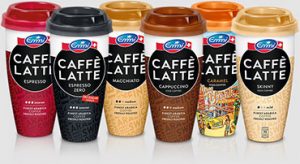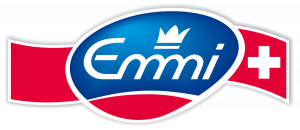
Drug advertisements on Swiss television or radio, about tobacco and alcohol are prohibited (Scruzzi 2015). However those drugs can be advertised in theatres after 7 p.m., on newspapers and cultural or sportive events (Bundesamt für Gesundheit 2015). Other drugs advertisements about coffee and painkillers like ASPIRIN for headache, are shown quite frequently on TV and wherever you go.
So, the drug I chose is coffee, specifically Emmi’s product line Emmi Caffè Latte. Here you can find the link to my advertisement: https://www.youtube.com/watch?v=VifHlt90N34.
I picked coffee as my drug, because I drink it almost every morning. At home, I bought Emmi Caffè Latte a lot, because it was practical to carry, to drink it on my way to school, to buy and drink it when I was on a coffee break with friends or whenever I felt exhausted and felt like I needed some kind of power.
Emmi’s history and mission (Emmi Deutschland, Über Uns):
- Emmi Caffè Latte is a brand of Emmi AG, created in 2004.
- Emmi AG is one of the largest diary producer in Europe, the largest Swiss milk processor and a worldwide renowned specialist for Swiss cheese.
- Emmi has it’s headquarters in Lucerne, Switzerland (established in 1907), but it also has several subsidiary companies in other countries: Germany, Belgium, Netherlands, Austria and UK. In these markets, outside of Switzerland, Emmi concentrates on brand concepts and specialties that work best in the specific country and society.
- 1947, they first sold cheese and yoghurt under the brand name Emmi. In 1998 the first subsidiary company was established in Germany.
- As consummation of coffee and drinks with caffeine started to become a trend in 2004, Emmi hopped on the coffee train and created their new trend product Emmi Caffè Latte.

- Starting 2010 the Emmi started to be recognized more and more. A new positioning of Emmi Germany and an image design (a typical Swiss wrapping, with a red and with Swiss flag and three mountain peeks on blue background) helped people to recognize the brand faster. A Germany wide TV campaign of Emmi Caffè Latte was the ultimate step to be fully recognized and established in the market.
- In February 2011, Emmi became partner of the FIS Alpine Ski World Championships in Garmisch-Partenkirchen. Starting 2011, Emmi’s product line Emmi Caffè latte, became official partner of ProSieben’s (German TV Channel) success format Germany’s Next Topmodel. In 013 EMMI launched the limited edition Emmi Caffè Latte Caramel New York Edition with a TV spot on every relevant channel. In 2014 Emmi expanded the range of Emmi Caffè Latte of the trend product Emmi Chai Latte, with Vanilla and classic flavor.
- As of today Emmi Germany is still an official partner with Germany’s Next Topmodel and still successful with all their new product lines, but mostly Emmi Caffè Latte.
“What started out as just an idea back in 2004 is now a global success story. In 2012 we sold more than 100 million cups [of Emmi Caffè Latte] and it’s you we have to thank for this.” (Emmi Deutschland, Über Uns)
From Ski Champions to Germany’s Next Topmodel:
As previously described, Emmi and Emmi Caffè Latte have main sponsors like FIS Ski Alpine World Cup and TV Show: “Germany’s Next Topmodel”. Both of those have a very large audience.
Picture
FIS Ski World Cup attracts sportive people and people interested in Winter Sports or just fans of particular skiers.

For example some the Swiss Skiers (e.g. Wendy Holdener) have Emmi as a tricot sponsor during the Ski World
Championship. I think the message they want to bring across is: drink coffee and be energized and become Slalom Vice World Champion and Combined Alpine World Champion (Season 2016-17: Wendy Holdener).
- Happy feelings
- Shows the winner of the FIS Slalom World Championship: suggests that when drinking coffee everything is possible. Energetic. Sportive.
- Tricot #1. Stands for best, first, winner.
Video advertisement (https://www.youtube.com/watch?v=VifHlt90N34.)
The TV advertisement shown during Germany’s Next Topmodel shows a woman standing in front of a man, with a coffee in hand and then she starts dancing. They mostly want to grab the attention of younger people, but also people in their 40ties. I think it really is intended for a wide span of people. I guess they want to grab the attention of people who want to have fun und a happy, energized live. At least this is how the TV ad comes across.
- Happy feelings.

- Dancing as an indicator for energy.
- “So fresh. So you.” Slogan.
- Beautiful woman and handsome guy in the clip.
- Sensual presentation of fresh roasted coffee beans dripping in creamy milk.
The whole video or the picture doesn’t say a word about the specific ingredients or the amount of caffeine used. It is only labeled on the product itself. The video however shows, as described above, a short cut of freshly roasted coffee melding with milk. Dangers, potential (although limited) dependence, or addiction aren’t addressed. In fact the only thing they do say is their slogan “Emmi Caffè Latte. So Fresh. So You.”
Is Coffee addictive or dangerous?
Hanson, Venturelli, Fleckenstein (2015), state that caffeine is the most frequently and perhaps the most popular used drug in the world. Beverages and food contain caffeine and are consumed almost every day. The average intake of caffeine is approximately 289mg (= 2-3 cups of Coffee) for U.S. citizens. Caffeine have a similar chemical structure to xanthines.
Physiological effects of the xanthines according to Hanson, Venturelli, Fleckenstein (2015):
Xanthines influence several body functions, but the effects are viewed as short-term. Only when used in high doses or by severely ill people, the drugs can be dangerous.
According to Hanson, Venturelli, Fleckenstein (2015), 100-200mg of caffeine enhances alertness, causes arousal and diminishes fatigue. It is also commonly used to block drowsiness and heighten mental activities (e.g. Cup of Coffee in the morning to “wake up”). Caffeine stimulates formations of thoughts, but doesn’t improve our learning ability. An other effect of caffeine is that it diminishes boredom. As a result students listening to boring lectures or a dull professor, often drink caffeinated beverages.
After doses over 300mg, the effects of caffeine are reversed: insomnia, increased tension, anxiety, flushed face, nervousness, rambling thoughts and muscle twitches are the result.
Doses over 500mg “can be dysphoric (unpleasant) and can cause panic sensations, chills, nausea, and clumsiness” (Hanson, Venturelli, Fleckenstein (2015), p. 339).
How the heart and blood vessels respond to xanthines depends on the dose and previous experience.
Low doses (100-200mg) can increase, decrease or do nothing to the heart rate.
Higher doses (>500mg) increase the heart rate. Caffeine also causes minor vasodilation in most of the body, except the brain, where it causes vasoconstrictions. For most consumers the effect caffeine has on the cardiovascular system are minor, but for people with underlining heart disease it can be dangerous. Xanthines causes air passages to open and facilitate breathing.
Based on available information, there is no strong evidence that moderate caffeine intake leads to disease. In fact some even say that moderate caffeine consumption reduces the risk of degenerative diseases of the brain (e.g. Parkinson’s, Alzheimer). However, people with existing, severe medical problems may be at greater risk.
Following Hanson, Venturelli, Fleckenstein, caffeine causes limited dependence, the abuse potential is much lower and dependence doesn’t really interfere with daily routines.
However it can produce addiction in some people. When withdrawing they get headaches and 10% become depressed, anxious or fatigued without their 1-3 cups of coffee. Some even experience elements of withdrawal before they had their first cup in the morning.
In the end…
Coffee is a commonly used drug. Today, drinking coffee has become somewhat a ritualistic devotion for many: Drinking coffee first thing in the morning, or the coffee break.
Coffee – when drunk in moderation – doesn’t have any severe effects on the brain or body. Only people with underlining heart diseased or existing medical problems (e.g. psychiatric disorder), should be aware what they are at greater risk than others. But realistically coffee still has way less elements causing serious heath problems than alcohol or smoking.
One cup of Emmi Caffè Latte Macchiato has only 80mg caffeine (Emmi Deutschland, Produkte), so it is still under the threshold where alertness etc. effects are caused!
So I recommend drinking coffee, if you want. Be it in the morning as a part of your daily ritual or during the boring lecture you’re just enduring. Sure, there is a chance of addiction or dependence. But in most cases the dependence doesn’t influence our daily routines. Honestly, if we can’t drink coffee because there is a possibility of addiction or dependence, we as well can’t drink lemonade or eat chocolat, gums, fruits, meat,…. because in the end everything becomes addictive at some point.
References:
Hanson, G., Venturelli, P. J., & Fleckenstein, A. E. (2015). Drugs and society. Burlington, MA: Jones & Bartlett Learning.
Scruzzi, D. (2015, April 06). Alkohol, Tabak, Kredite: Werbung mit immer mehr Verbotsschildern | NZZ. Retrieved October 17, 2017, from https://www.nzz.ch/schweiz/werbung-mit-immer-mehr-verbotsschildern-1.18516991
Bundesamt für Gesundheit (2015, May). Basisinformationen zur Tabakwerbung. Retrieved October 12, 2017 from: https://www.bag.admin.ch/dam/bag/de/dokumente/npp/tabak/basisinformation-tabakwerbung.pdf.download.pdf/2015_Basisinformation_Tabakwerbung_DE.pdf.
Emmi Deutschland. Über uns. Retrieved October 12, 2017 from: https://de.emmi.com/de/ueber-emmi/.
Emmi Deutschland. Produkte. Retrieved October 13, 2017 from: https://www.emmi-caffelatte.com/de/macchiato
-Noémie Monnet